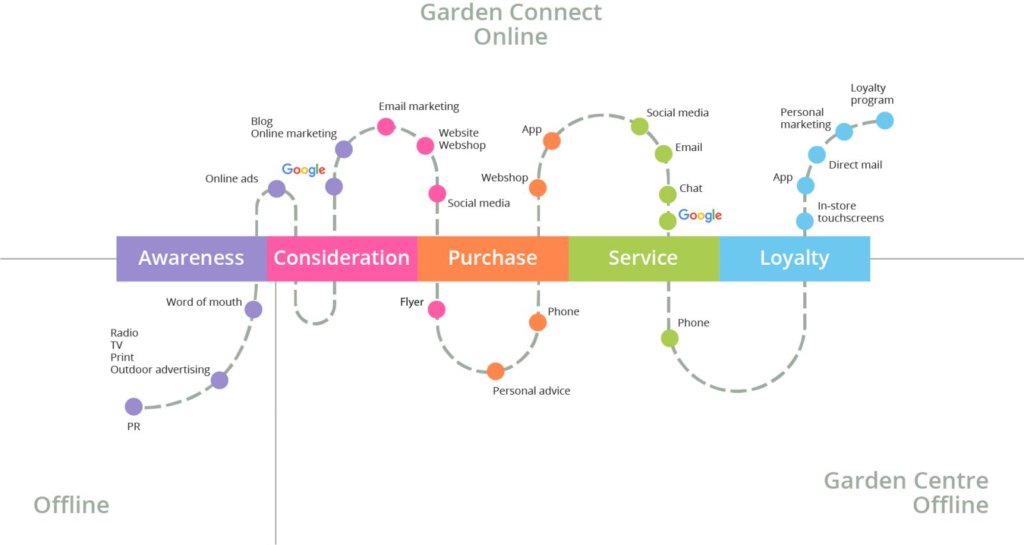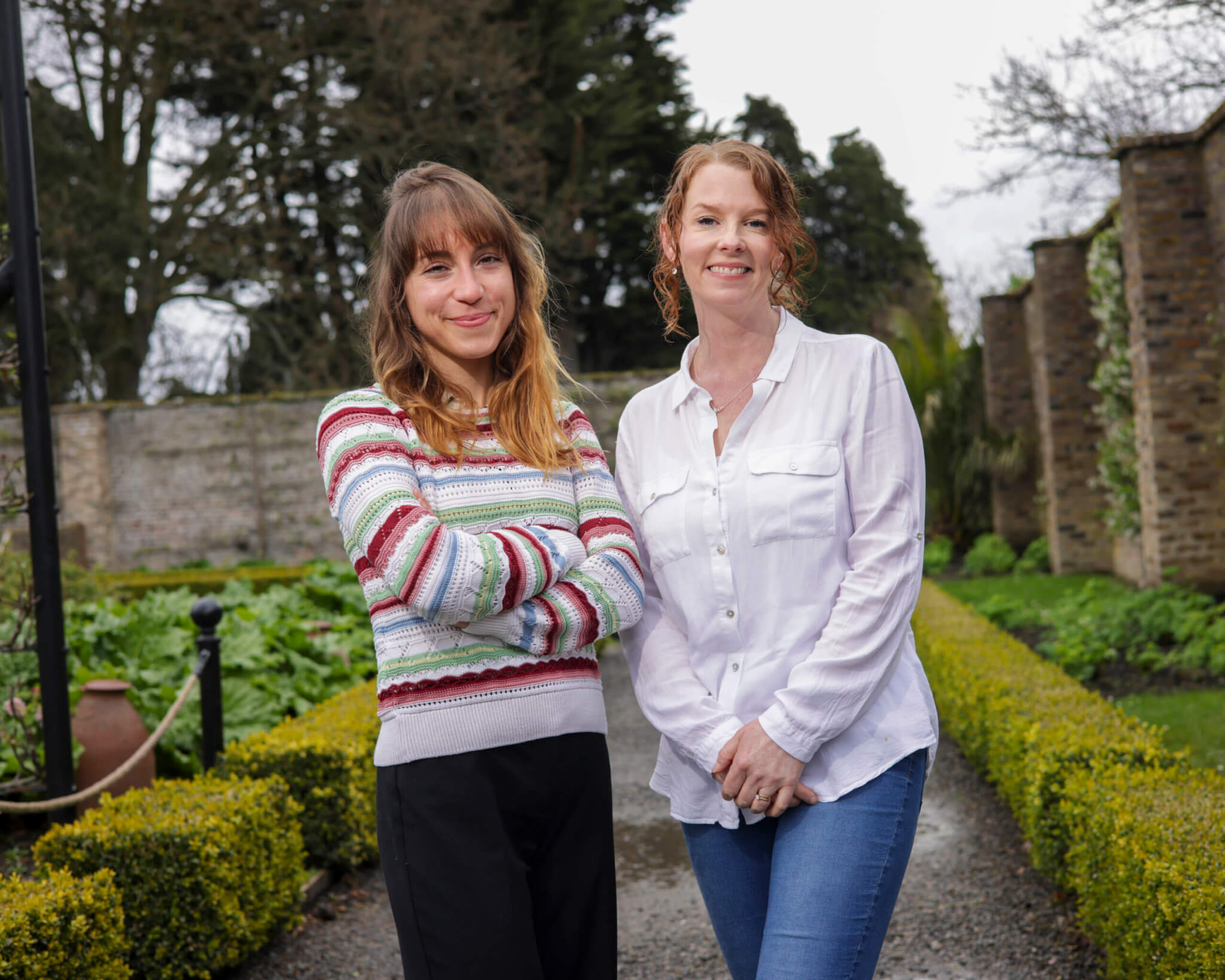Garden Connect: Why garden centres should understand the customer journey

Garden Connect sets out the blueprint on how garden centre retailers can drive more sales by understanding how the customer comes to the conclusion on what to buy and where, in other words, understanding the customer journey.
10 March 2020
The team at Garden Connect has developed a graph to set out and explain the customer journey as a way of helping garden centre retailers drive sales, growth, and loyalty.
As you can see, three factors are playing a decisive role during the customer journey:
- Offline marketing – bottom.
- Online marketing – top.
- Your garden centre.
One cannot be successful without the other and the team go through explaining each of the five steps by introducing an example customer, Suzan.
Suzan is a 42-year old woman living in Dublin, busy with her career but she loves to do some gardening every now and then. She’s not a hardcore gardener, she just hopes her plants survive a few years. She’s growing an apple tree for her kids to have a home-grown apple pie next autumn. So now that you’ve met Suzan, it’s time to explain how she bought a new pruning shear at her local garden centre.
Step one: awareness
Suzan is pretty inexperienced so she doesn’t know she needs to prune her apple tree late winter. Luckily, she was reading a news article in the newspaper about gardening and she read she had to do just that.
Since she wants to have apples to make her apple pie in September, she went to Google and searched for “How to prune an apple tree”. She looked up the instructions on Wikihow.com. Suzan realised she needed a new pruning shear since the old one was a bit rusty. So now she’s aware she needs to buy a new pruning shear: the first step of the customer journey has been taken.
Step two: consideration
After putting the kids to bed, she grabbed her iPad and went to Google to search for “pruning shear apple tree”. She doesn’t have a clue yet what pruning shears to buy so she hopes websites will give her relevant information.
Suzan opens a few webshops but they don’t really explain if the pruning shears are suitable for apple trees. Luckily, she ended up on growveg.com which explains exactly which shears are required for apple trees.
Now she knows she needs a lopper to reach the high branches. The next Google search she does is “best loppers”. Suzan ends up on the gardeners.com website explaining all the different brands and models and their pros and cons. She takes some time to read and compare products: she’s considering her options.
Eventually, Suzan decides the Fiskars Telescopic Lopper fits her budget and requirements.
The purchase phase has two options: online or offline. The Garden Connect team explains both of them below since the customer journey differs per channel.
Step three: purchase
If Suzan wants to buy this lopper online, she will enter a keyword like “buy Fiskars Telescopic Lopper” or “Fiskars Telescopic Lopper online”. The keywords “buy” and “online” are declaring her intention: she wants to buy it online.
Via Google Shopping, she clicks on a link pointing her to a website and she orders the lopper. This is where the online journey ends, but how about an offline purchase?
Usually, customers don’t narrow their search process down to a specific product if they want to buy offline. Suzan would have stopped after realising she needs a telescoping lopper and would try to find a local store.
Customers who are in the market for these tools normally just walk in, pick one from your range, and buy it. They won’t narrow it down unless it’s an expensive product. In that case, Suzan would have entered a keyword like “Lopper Dublin” to find a garden centre (or any other store) selling loppers in her area.
The keyword Suzan uses makes her intention clear: she wants to shop in a brick and mortar store.
Step four and five: service and loyalty
After Suzan bought her new lopper, she’s still unsure how to use it properly. She goes to YouTube to look up a video about pruning apple trees by using the search word “prune apple tree”. A video of Crocus shows exactly how to prune her apple tree: Crocus.co.uk is clearly putting a lot of effort in the service they provide by creating videos like this.
Because Suzan bought the lopper in-store and used her loyalty card, you can send an e-mail to her before the winter kicks in: “How to prepare your garden tools for winter?”. This e-mail explains to her how to clean and store the garden tools Suzan bought at your garden centre. Now Suzan knows how to store her lopper and to prevent it from getting rusty.
Going the extra mile helps to build a long-term relationship with your customers. For most garden centres, the story ends after step three. But it is recommended you to look at step four and five as well.
If you focus on step one through three, you might get customers in your garden centre (or on your webshop). But if you optimise step four and five, some of your customers will become recurring visitors and ambassadors of your garden centre.
Why does the customer journey matter?
With every purchase, customers follow these steps to make a decision. It can take a few minutes or a few weeks, but every purchase goes through this cycle. If you understand this cycle, you can easily identify where you should focus on to increase your traffic flow or online sales.
Garden Connect uses the customer journey frequently to discuss what online marketing channel should be used in which stage. Doing the right things will help you to get customers like Suzan to your garden centre.
For more on Garden Connect and what they can do for your business, see here.



 Print
Print









Fans 0
Followers